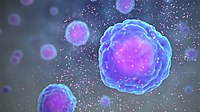
Photo from wikipedia
Systemic inflammation has been shown to play a pivotal role in the pathogenesis of moyamoya disease (MMD). Brain-gut peptides exhibit regulatory effects in the secretion of proinflammatory cytokines. To investigate… Click to show full abstract
Systemic inflammation has been shown to play a pivotal role in the pathogenesis of moyamoya disease (MMD). Brain-gut peptides exhibit regulatory effects in the secretion of proinflammatory cytokines. To investigate the association between brain-gut peptides and inflammation in the occurrence of MMD, 41 patients with MMD, as well as 74 age- and sex-matched healthy individuals were enrolled. The levels of four brain-gut peptides (vasoactive intestinal polypeptide (VIP), cholecystokinin (CCK), somatostatin (SST), substance P (SP)) and three proinflammatory cytokines (interleukin-1β (IL-1β), tumor necrosis factor-α (TNF-α), IL-12) in the serum and cerebrospinal fluid (CSF) were measured using the enzyme-linked immunosorbent assay. The associations between brain-gut peptides and proinflammatory cytokines were estimated according to the multiple linear regression and correlation analyses. MMD patients exhibited significantly lower levels of VIP, CCK, and SST and higher levels of IL-1β, TNF-α, and IL-12 in the serum compared with healthy controls. Multiple logistic regression analysis showed that decreased VIP, CCK, and SST levels were independent predictors of the occurrence of MMD. Negative correlations were observed between the VIP and proinflammatory cytokines, including IL-1β, TNF-α, and IL-12 (serum vs. CSF). Significant negative correlations were also found between CCK and IL-1β, as well as IL-12 (serum vs. CSF). SST was negatively correlated with IL-1β and TNF-α in the serum and IL-1β only in the CSF. In addition, the levels of VIP, CCK, SST, and proinflammatory cytokines IL-1β and TNF-α in the serum were correlated with those measured in the CSF. Collectively, lower levels of VIP, CCK, and SST may be associated with the pathogenesis of MMD and act as clinically useful biomarkers along with the levels of proinflammatory cytokines.
Journal Title: Mediators of Inflammation
Year Published: 2020
Link to full text (if available)
Share on Social Media: Sign Up to like & get
recommendations!